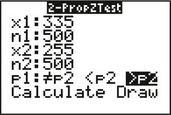Printed Page 614
STEP-BY-STEP TECHNOLOGY GUIDE: Z Test and Z Interval p1 − p2
(Example 15 is used to illustrate the procedure.)
TI-83/84
Z Test f or p1 − p2
- Step 1 Press STAT and highlight TESTS.
- Step 2 Select 6 (for the 2-Prop ZTest).
- Step 3 For x1, enter the number of successes in the first sample, 335.
- Step 4 For n1, enter the size of the first sample, 500.
- Step 5 For x2, enter the number of successes in the second sample, 255.
- Step 6 For n2, enter the size of the second sample, 500.
- Step 7 For p1, choose the form of the hypothesis test. For Example 15, choose > p2 and press ENTER (Figure 19).
- Step 8 Highlight Calculate and press ENTER. The results are shown in Figure 16 in Example 15.
Z Interval for p1 − p2
Follow the same steps as for the Z Test for p1 − p2, except “Select B: 2-PropZInt.” Also, to select confidence level (C-Level), enter 0.95 for 95%, for example.

FIGURE 19
EXCEL
Use the JMP add-in for Excel.
MINITAB
Z Test and Z Interval for p1 − p2
- Step 1 Click Stat > Basic Statistics > 2 Proportions….
- Step 2 Select Summarized data.
- Step 3 For the Number of events row, enter x1 for Sample 1 and x2 for Sample 2.
- Step 4 For the Number of trials row, enter n1 for Sample 1 and n2 for Sample 2.
- Step 5 Click Options…, enter the Confidence level, the Hypothesized difference, and select the form of the Alternative hypothesis. Under Test method, select use the pooled estimate of the proportion. Then click OK twice.
CRUNCHIT!
Z test and Z Interval for p1 − p2
We will use the data from Example 15.
- Step 1 Click Statistics, highlight Proportion, and select 2-sample. Select the Summarized tab. For Sample 1, enter n : 500 and Successes: 335; for Sample 2, enter n : 500 and Successes: 255.
- Step 2
- For the hypothesis test, select the Hypothesis Test tab, enter the Difference of proportions under null hypothesis, choose the correct form of the Alternative hypothesis, and click Calculate.
- For the confidence interval, select the Confidence Interval tab, enter the Confidence Interval Level (%), and click Calculate.
[Leave] [Close]